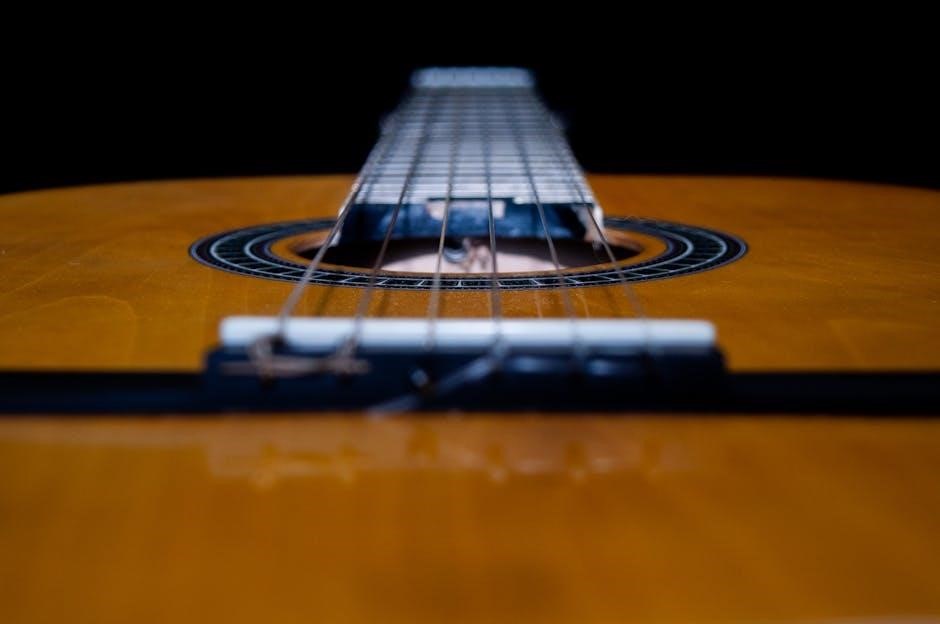Learning guitar scales is essential for improving technique, understanding music theory, and enhancing creativity. Printable PDF guides offer clear diagrams and exercises for all skill levels and styles.
Why Practice Guitar Scales?
Practicing guitar scales improves technique, enhances musical understanding, and boosts creativity. Scales are the foundation of music, aiding in composition, improvisation, and soloing. They increase finger dexterity, strength, and familiarity with the fretboard. Mastering scales allows musicians to explore various genres and styles, from rock to jazz. Regular practice enhances versatility, enabling guitarists to adapt to different musical situations. Additionally, scales provide a structured framework for understanding chord progressions and harmonic relationships, making them indispensable for both beginners and advanced players. PDF resources offer organized exercises to streamline the learning process.
How to Read Scale Diagrams
Reading scale diagrams is crucial for effective practice. These diagrams typically represent the guitar fretboard, with dots indicating notes and numbers showing finger placement. The vertical lines are strings, and horizontal lines are frets. Open strings are at the top (0 fret), while higher frets are toward the bottom. Understanding the layout helps in visualizing scales and applying them musically. PDF guides often include clear diagrams with color-coded notes and patterns, making it easier to identify intervals and play smoothly across the fretboard.
Major Scales
The major scale is a fundamental musical structure, consisting of seven notes with a specific interval pattern. It is widely used in various music genres due to its versatility and melodic appeal, forming the basis of many chord progressions and solos. Mastering major scales enhances improvisation and composition skills, making them a cornerstone of guitar education and practice.
The Structure of the Major Scale
The major scale is built using a specific sequence of whole and half steps: W-W-H-W-W-W-H. This pattern creates a bright, uplifting sound. Each scale consists of seven notes, with the eighth note being the octave. For example, the C major scale is C-D-E-F-G-A-B-C. Understanding this structure is crucial for playing scales correctly and improvising effectively. Guitar PDF charts often provide fretboard diagrams to help visualize these patterns, making practice more efficient and accessible for musicians of all levels.
Major Scale Fretboard Diagrams
Major scale fretboard diagrams provide a visual guide for playing scales across the guitar neck. These diagrams typically show note positions, finger placements, and patterns for each key. They often include octave repetitions and highlight key intervals, making it easier to navigate the fretboard. PDF resources offer comprehensive diagrams for all major scales, allowing players to practice efficiently and build familiarity with scale shapes. These tools are invaluable for developing muscle memory, improving technique, and expanding musical understanding.
Chord Progressions for Practicing Major Scales
Chord progressions are essential for applying major scales in a musical context. Common progressions like I-IV-V or ii-V-I help integrate scales into solos and improvisation. Many PDF guides include chord charts and backing tracks to practice scales over popular sequences. These resources often align scales with chords, making it easier to understand how scales fit within key-based music. Practicing scales over chord progressions enhances phrasing, timing, and tone, while building a stronger connection between theory and performance.

Minor Scales
Minor scales add depth and emotion to music. Natural, harmonic, and melodic minors are essential for guitarists, offering rich, versatile sounds across various musical genres and styles.
Natural Minor Scales
Natural minor scales, also known as Aeolian mode, are fundamental for guitarists. They consist of seven notes with a specific whole-half step pattern. These scales are versatile and widely used in various music genres. Many PDF resources provide fretboard diagrams for all natural minor scales across different keys, making it easier for players to learn and practice. Understanding natural minors enhances improvisation and composition skills, allowing guitarists to create emotionally rich melodies and solos. Regular practice with these scales helps build finger dexterity and musical understanding.
Harmonic Minor Scales
Harmonic minor scales are a variation of natural minors, with a raised seventh note. This alteration creates a distinctive sound and adds tension. Guitarists use these scales to add emotional depth and complexity to their playing. The harmonic minor scale is particularly useful in jazz and classical music for creating rich, dramatic melodies. Many PDF resources provide detailed fretboard diagrams and exercises for harmonic minor scales in all keys. Practicing these scales enhances technique and understanding of advanced music theory, making them a valuable tool for serious guitarists.
Melodic Minor Scales
Melodic minor scales are versatile and widely used in jazz and classical music. They differ from natural minors by raising the 6th and 7th notes when ascending, creating a distinct, emotional sound. When descending, the scale mirrors the natural minor. Guitarists often use melodic minors to add complexity and tension to solos. Many PDF resources include detailed fretboard diagrams and exercises for melodic minor scales in all keys. These scales are essential for advanced players seeking to expand their musical expression and technique, offering a rich foundation for improvisation and composition.

Pentatonic and Blues Scales
Pentatonic scales are simple, versatile, and widely used in various music genres. The blues scale adds a “blue note” for emotional depth. Both are essential for improvisation and solos.
The Pentatonic Scale
The pentatonic scale is a fundamental and versatile musical tool, consisting of five notes. It is widely used in various genres, including rock, blues, and jazz. The minor pentatonic scale is particularly popular for its emotional depth and ease of use, while the major pentatonic scale offers a brighter, happier sound. Both scales are essential for improvisation and solos. Learning these scales enhances your ability to create melodies and understand chord progressions. Fretboard diagrams in PDF guides provide clear visual aids for mastering these scales effectively.
Blues Scales
The blues scale is a cornerstone of blues and jazz music, offering a rich, emotional sound. It consists of five notes plus the “blue” third, creating tension and feeling. Guitarists use this scale to add depth to solos and improvisations. The scale is versatile and can be applied to various chord progressions. Practicing blues scales helps develop phrasing and expression. PDF guides provide fretboard diagrams and exercises for mastering this essential scale, making it easier to integrate into your playing and connect with the soulful essence of blues music.

Modes of the Major Scale
Modes are variations of the major scale, each starting on a different note within the scale, creating distinct emotional colors and harmonic possibilities for guitarists to explore.
Ionian Mode
The Ionian mode is the same as the major scale, characterized by its bright, uplifting sound. It follows the W-W-H-W-W-W-H interval pattern, making it a foundation for many musical styles.
Guitarists often use the Ionian mode for creating harmonically rich solos and melodies. PDF resources provide detailed fretboard diagrams and exercises to master this essential scale. Understanding the Ionian mode enhances your ability to improvise and compose music confidently.
Dorian Mode
The Dorian mode is a versatile musical scale with a W-H-W-W-W-H-W interval pattern. Known for its warm, melodic sound, it’s widely used in jazz, rock, and fusion music.
Guitarists often employ the Dorian mode for crafting solos and compositions that evoke emotional depth. PDF resources provide detailed fretboard diagrams and exercises to master this mode. Understanding the Dorian mode enhances your ability to create complex, expressive melodies and improvisations. It’s a key tool for expanding your musical vocabulary and versatility on the guitar.
Phrygian Mode
The Phrygian mode has a distinct sound, characterized by its H-W-W-W-H-W-W interval pattern. It’s often associated with flamenco and Middle Eastern music due to its exotic, tense quality. Guitar PDFs provide fretboard diagrams and exercises to help master this mode. The Phrygian mode is ideal for creating dramatic, emotional solos and compositions. Its unique intervals make it a favorite for adding color to musical phrases. Practicing this mode expands your tonal palette and enhances your ability to play in various musical styles with authenticity and depth.
Lydian Mode
The Lydian mode is characterized by its H-W-W-W-H-W-H interval pattern, featuring a raised 4th scale degree. This gives it a bright, yet tense sound, often used in jazz and fusion music. Guitar PDFs provide detailed fretboard diagrams and exercises for mastering the Lydian mode. Its unique tonal quality makes it ideal for creating complex, adventurous solos. Practicing the Lydian mode enhances your ability to play over extended chords and adds depth to your improvisational skills. It’s a versatile mode that bridges melodic and harmonic exploration.
Mixolydian Mode
The Mixolydian mode is a major scale with a lowered 7th degree, creating a H-W-W-W-H-W-H interval pattern. It has a distinct, slightly tense sound often used in jazz, blues, and rock. Guitar PDFs provide fretboard diagrams and exercises for mastering this mode. The Mixolydian mode is particularly effective for improvising over dominant chords. Its versatility makes it a favorite among guitarists, offering a rich, dynamic tonal palette for solos and compositions. Regular practice enhances your ability to navigate this mode confidently across the fretboard.
Aeolian Mode
The Aeolian mode, also known as the natural minor scale, has a H-W-W-H-W-W-H interval pattern. It is commonly used in rock, jazz, and classical music to create somber or introspective melodies. Guitar PDFs often include fretboard diagrams for the Aeolian mode, showcasing its structure across the neck. This mode is versatile and can be applied to various musical contexts, offering a rich, emotional sound. Regular practice with exercises from PDF guides helps in mastering its fingering and application in solos and compositions.
Locrian Mode
The Locrian mode is the seventh mode of the major scale, known for its distinctive, dissonant sound. Its interval pattern is H-W-W-H-W-W-W, creating a tense, unstable feel. Often used in jazz and fusion to add dramatic effects, the Locrian mode is less common but highly expressive. Guitar PDFs typically include fretboard diagrams for the Locrian mode, making it easier to visualize and play. Regular practice with these resources helps musicians master its unique fingering and apply it effectively in solos or compositions, adding depth to their musical creations.

Advanced Scales
Advanced scales, such as the whole tone and chromatic scales, provide intricate musical textures, allowing guitarists to explore deeper harmonic possibilities and refine their advanced techniques effectively.
Whole Tone Scale
The whole tone scale is an advanced scale consisting of six notes, each a whole step apart. It creates a unique, dissonant sound often used in jazz and experimental music; Guitarists can use this scale to add tension and complexity to solos or compositions. The scale’s uniform interval structure makes it versatile for creating dramatic harmonic effects. PDF guides provide fretboard diagrams and exercises to master this scale across the neck, enhancing your musical expression and technique.
Diminished Scale
The diminished scale is a symmetrical scale with a unique, dissonant sound. It alternates between whole and half steps, creating a tense, dramatic effect. Guitarists use it in jazz and advanced compositions to add complexity. The scale’s symmetry allows for multiple applications across the fretboard. PDF resources provide detailed diagrams and exercises to help master this scale, enabling players to explore its rich harmonic possibilities and expand their musical versatility effectively.
Chromatic Scale
The chromatic scale includes all twelve semitones within an octave, offering a wide range of tonal possibilities. It is often used in advanced guitar playing to create complex, intricate passages. PDF guides provide fretboard diagrams and exercises to master this scale, emphasizing its versatility in various musical genres. The chromatic scale is essential for developing dexterity and understanding advanced techniques, making it a valuable tool for serious guitarists seeking to expand their musical expression and technical proficiency.

Resources and Further Reading
Downloadable PDFs like LIZA ZOE GUITAR SCALES.pdf and Quatre Images du Japon.pdf offer detailed diagrams and exercises. These resources cover major, minor, and advanced scales, aiding comprehensive practice and mastery.
Recommended PDFs for Guitar Scales
Downloadable resources like LIZA ZOE GUITAR SCALES.pdf and Quatre Images du Japon.pdf provide comprehensive scale diagrams and exercises. These PDFs cover major, minor, pentatonic, and blues scales, as well as advanced options like whole tone and diminished scales. They include fretboard charts for all keys in standard tuning, making them ideal for both beginners and experienced players. Additional materials offer practical tips and chord progressions to enhance practice. These resources are available online and can be printed for easy reference, ensuring a well-rounded learning experience.
Additional Materials for Practice
Beyond PDFs, video lessons and online tutorials offer interactive learning. Websites provide chord charts, jam tracks, and detailed instructions. Supplements like Fastrack Chords & Scales and ATTITUDE! include practical exercises. These materials help guitarists apply scales in real musical contexts, improving both technique and creativity. They often include tips for effective practice, such as using metronomes or focusing on specific fretboard positions. These resources cater to all skill levels, ensuring a comprehensive and engaging learning experience for guitar players of any background or goal.
Mastering guitar scales is a cornerstone of musical development, enhancing technique, theory understanding, and creativity. PDF guides offer comprehensive resources, from major and minor scales to advanced modes. Consistent practice with these materials will deepen your musical knowledge and versatility. Embrace the journey, explore various styles, and continually challenge yourself to grow as a guitarist. The detailed diagrams and exercises in these PDFs provide a robust foundation for lifelong learning and artistic expression.
